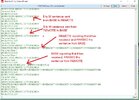camerart
Well-Known Member
Hi,
About 4 years ago, I got the idea for a little project. I wanted to control mechanical items, in this case a Tricopter, by sending a location, which means Altitude, LAT and LONG plus other things. LAT LONG etc doesn't need to be used, if for eaxample I wanted to control 'say' a robot, where some other control would be sent.
Anyway 4 years later I/plus lots of assistance from forums etc, have got it going. When I say that, I mean the Transmitter and Receiver, can send between them DATA such as mentioned, inculding peripherals: Radio, GPS, Altimeter, compass, incremental encoder and Joysticks.
Thanks, for all of the help.
Camerart.
About 4 years ago, I got the idea for a little project. I wanted to control mechanical items, in this case a Tricopter, by sending a location, which means Altitude, LAT and LONG plus other things. LAT LONG etc doesn't need to be used, if for eaxample I wanted to control 'say' a robot, where some other control would be sent.
Anyway 4 years later I/plus lots of assistance from forums etc, have got it going. When I say that, I mean the Transmitter and Receiver, can send between them DATA such as mentioned, inculding peripherals: Radio, GPS, Altimeter, compass, incremental encoder and Joysticks.
Radio control by location
Hi, I play with Tricopters, which are a 3x propellor helicopters. I've enjoyed making them and learning to fly, but I don't find it easy, with eyes not like they used to be, I sometimes find I can't see which way round they are. If there's a risk of them flying away, I crash and repair them...
www.electro-tech-online.com
Thanks, for all of the help.
Camerart.
Last edited:


